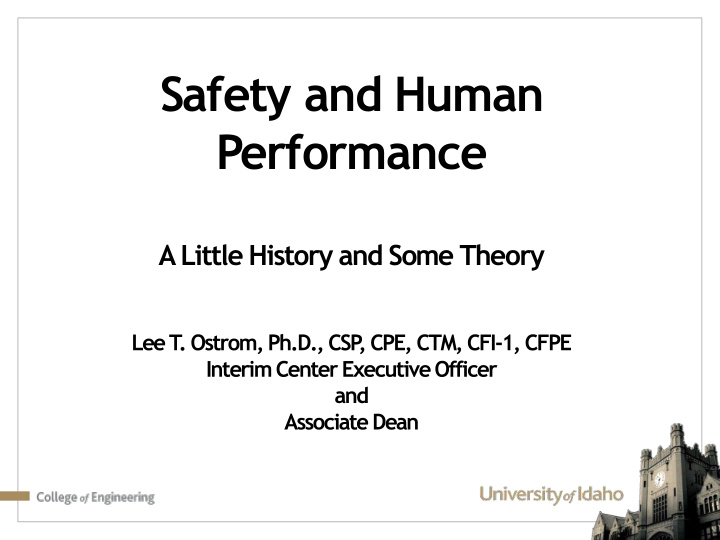



Safety and Human Performance A Little History and Some Theory Lee T . Ostrom, Ph.D., CSP , CPE, CTM, CFI-1, CFPE Interim Center Executive Officer and Associate Dean
Agenda • T wo minutes on my career • Classical safety program • Times were changing - VPP • Behavioral-Based Safety comes of age • Human Performance Improvement/Safety
A Little on my Career • 1980 completed my MS in Interdisciplinary Studies Occupational Safety and Health – Texas Tech • 1981 Safety Coordinator/Engineer at PPG Industries in LaPorte, TX • 1985 Returned to Texas Tech for a PH.D. in Industrial Engineering Specializing in Ergonomics • Graduated December 1988 • Started at the Idaho National Engineering (INL) Lab in 1989 in the Human Factors (HF) Group
A Little on my Career • In 1991 a colleague and I developed and published a safety culture survey that is still cited today • Worked in the nuclear , aerospace, and military industries examining tasks and workplaces for improvements using various HF , ergonomic, and risk analysis tools • 2000 came to the University of Idaho and continued on this applied research path • Helped develop the human performance safety online certificate that continues to be very popular
Classical Safety Program • Reduction in accidents for reduced worker’s compensation costs • Safety contests • Conformance to regulations to avoid fines • Worker incentive programs • Slogans and posters • Heavy-handed punishment for safety violations; lack of just culture
Classical Safety Program
Reduction in Accident Rate Example 1. Reactive — An injury must occur before the system can react 2. Not specific — Do not indicate exactly what needs to be done on-the-job to maintain or improve safety 3. Low impact — Hard to change at-risk behaviors that are at “habit strength” 4. Negative — focusing on accident rates highlights worst aspect of work
Basics of VPP • A program that leads to enhanced worker safety and health protection • The opportunity to develop a cooperative relationship between management, labor , and the government • A program designed to recognize and promote effective safety and health management • Not just an award, a continual process to achieve excellence
Times were Changing • 1979: The CAL/OSHA-Bechtel experiment • 1982: OSHA announces VPP • 1982: First site joins VPP • 1992: 100th Site Joins VPP • 1994: DOE initiates VPP • 1998: Federal worksites eligible for VPP • 2003: Reached 1000 sites in November 2003 • 2008: 2000th site in VPP Presently: Over 2000 sites in VPP Nationwide
Behavioral-Based Safety • Identification of Safety Targets — behaviors or conditions that are critical to performing safely • Increasing the frequency of those critical safe behaviors and conditions
Behavioral-Based Safety Is Proactive — by providing measures of safety targets on-the-job that can be used to avoid injuries Is Specific — s afety target data indicates exactly what can be done to maintain and improve safety Can Change Attitudes & Culture — higher impact on at- risk behaviors that are at “habit strength” Is Positive — safety achievements and improvements are the focus
Behavioral-Based Safety Target Safety Related Behaviors & Conditions Increase Frequency of Frequent Observation Behaviors & Conditions Directly Feedback Related to Safety Reinforcement/Problem Solving
Elements of Current Safety Quick History of Human and Performance Human Performance • Anthropometry • Human Factors Psychology • Industrial Design • Applied Psychology • Industrial Engineering • Cognitive Science • Industrial and Organizational • Cognitive Psychology Psychology • Engineering Psychology • Operations Research • Aviation Psychology • Physiological Psychology • Psychology • Ergonomics • Risk Assessment • Experimental Psychology • Safety • Human Factors • Statistics • Human Systems Integration
Human Performance Quick Overview • Scientific understanding of the properties of human capability (Human Factors Science). • The application of this understanding to the design, development and deployment of systems and services (Human Factors Engineering). • Equipment Design, Task Design, Environmental Design, Training, Selection • The art of ensuring successful application of Human Factors Engineering to a program (sometimes referred to as Human Systems Integration)
Human Factors • Human factors involves the study of all aspects of the way humans relate to the world around them, with the aim of improving operational performance, safety, through life costs and/or adoption through improvement in the experience of the end user. • The terms human factors and ergonomics have only been widely used in recent times; the field's origin is in the design and use of aircraft during WW II to improve aviation safety.
Human Factors Human factors are sets of human-specific physical, cognitive, or social properties which either may interact in a critical or dangerous manner with technological systems, the human natural environment, or human organizations, or they can be taken under consideration in the design of ergonomic human-user oriented equipment.
Human Performance Human Performance Technology (HPT), also known as Human Performance Improvement (HPI), "uses a wide range of interventions that are drawn from many other disciplines, including total quality management, process improvement, behavioral psychology, instructional systems design, organizational development, and human resources management" (ISPI, 2007).
Human Performance • HPT is a systematic approach to improving individual and organizational performance (Pershing, 2006). • HPT stresses a rigorous analysis of the requirements of organization, process and HP for new design and/or identifying the causes for performance gaps, and attempts to provide new designs and/or solutions to improve and sustain performance and to evaluate the results against the requirements.
ance Academic Certificate Human Performance Certificate INDT 450 Occupational Safety or TM 528 Accident Investigation (3 cr) INDT 362 Behavior Based Safety (3 cr) INDT 464 Human Performance Fundamentals (3 cr) INDT 466 Human Performance Field Investigation (3 cr)
CONTACTS • Dr. Lee Ostrom • ostrom@uidaho.edu • 208-757-5427 • Alice Allen • alicew@uidaho.edu • 208-757-5452
Questions?
Recommend
More recommend